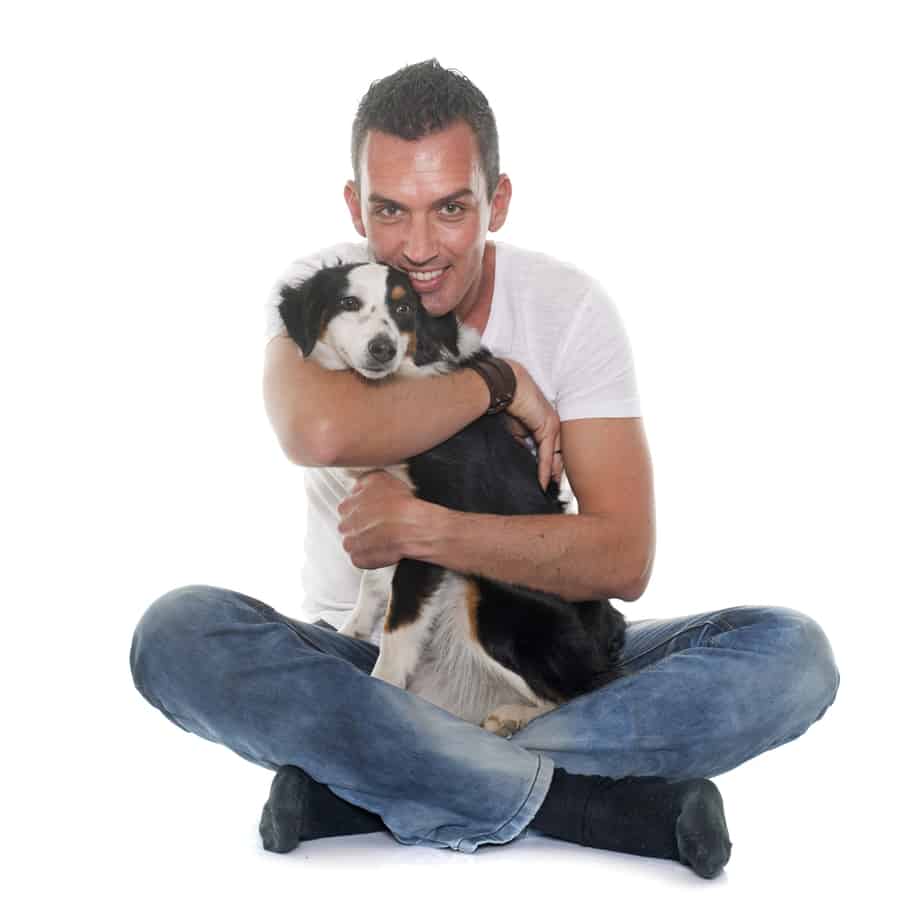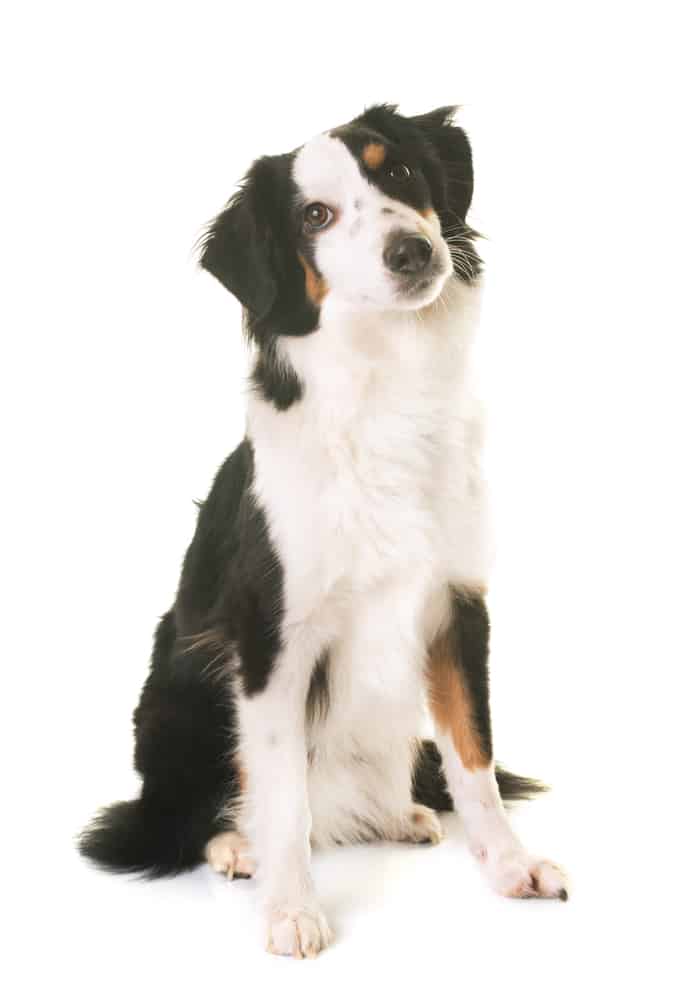Complete Guide To The Miniature American Shepherd: Health, Grooming, Feeding and More
The Miniature American Shepherd is an equestrian’s delight and a faithful family friend. Bright and bubbly, they’re devoted, adventure-ready travel companions prepared to work or play.
I’ve been seeing this breed a lot more in the past few years in my veterinary practice and they’re wonderful little dogs.
Table of Contents
How Big Do Miniature American Shepherds Get?
| Height | Weight | |
| Male | 14″ – 18″ at the shoulder | 20-40 lbs |
| Female | 13″ – 17″ at the shoulder | 20-40 lbs |

What Do Miniature American Shepherds Look Like?
The Miniature American Shepherd, or MAS, was bred in the United States from compact Australian Shepherd stock, so it’s no coincidence the two breeds share similar traits.
Their mid-length double coats come in the same four colors:
• Black
• Red
• Blue Merle
• Red Merle
Tan points and white markings are common with no rhyme or reason to their pattern. Their eyes come in a kaleidoscope of shades including brown, blue, or hazel or amber with marbling or multicolored flecks.
Tails are docked or naturally bobbed, and ears hang but with lift — they appear attentive. Miniature American Shepherds are unique among US-bred dogs, but puppies are easily mistaken for the Australian Shepherd and adults are similar in size to the Shetland Sheepdog.
What Is The Personality Of A Miniature American Shepherd?
The Miniature American Shepherd is perky and playful. Loyal, they thrive on human companionship and make durable companions for kids. Bred to herd, it’s anyone’s guess who’ll exhaust who first.
Alert and perceptive, they need t least an hour of daily exercise essential to control their boundless energy. Games that give them something to chase utilize their herding skills and prevent boredom. It’s critical to keep them engaged — they’ll be miserable living life on the sidelines.

Intelligent but with minds of their own, early training is recommended whether they’re traveling the equestrian circuit or the neighborhood — good manners are a must. But as long as they get enough activity, they’ll be happy anywhere from pastures to city parks.
How Much Grooming Do Miniature American Shepherds Need?
Miniature American Shepherds have weather-resistant double coats — a short wooly layer to insulate them from the cold beneath a thick, luxurious top coat. It’s a lot of hair to manage, but the process is straightforward and keeps fur off the furniture.
Twice-weekly brushing with a slicker removes dead hair and takes dirt with it. Choose a brush with tines long enough to reach the skin — it will thin the undercoat and better distribute skin oils for natural tangle resistance. Daily grooming combats heavier seasonal shedding.
The MAS’s thick mane and feathery hindquarters are prone to knots — tease them out with a steel comb to prevent matting. If brushed regularly, occasional bathing is all they need unless their coat is heavily soiled. Consistent care pays off.
Nail trimming isn’t as challenging as with other breeds because they run naturally short and exercise keeps them trim. But if you hear them click, it’s time to clip. Less prone to ear infections because their pinnae are lightweight and semi-erect, monthly cleaning should keep them free of irritation and odor.
How Much Exercise Does A Miniature American Shepherd Need?
The MAS are always looking for something to do. It doesn’t have to always be physical, but they need something to do. Long walks, trips to the dog park, going for a swim, or doing an agility class – these are all activities that the Miniature American Shepherd will love and excel doing.
They are not couch potatoes. In fact, if you leave your MAS at home for a decent part of the day without first tiring them out you’ll likely come home to a frustrated dog and a bit of a destructive mess.
On top of all the physical stimulation, they need to use their minds. This is one of the smartest breeds of dogs out there and they need to be challenged. They will learn basic commands and tricks quickly. Challenge them with more complex tricks and toys.

What Kind of Dog Food Is Good For A Miniature American Shepherd?
If your MAS is ridiculously active, then you might have a problem keeping them at a proper weight. If that’s the case, you’ll want to feed them a calorically-dense diet. Below are three diets that I think are great for the MAS for this reason. None of them are even close to being super expensive and all three have had a great deal of research behind them to prove their quality.
Please don’t listen to the folks at the pet store trying to convince you to buy a grain-free diet for your dog. There’s zero science behind that and vets are actually seeing diseases now related to feeding grain-free foods.
One of the coolest things you can do with your MAS (that may not work with other breeds) is to engage their mind at the same time that you are feeding them. My favorite toy/feeding strategies include:
How Long Does A Miniature American Shepherd Live?
12-13 years based on information from the AKC
What Health Problems Can Miniature American Shepherds Have?
This is still a relatively new breed of dog and we may start to see certain things develop as time goes by. I would watch out for dental disease, luxating patellas, and obesity as the dog ages.
However, this breed so far seems like a pretty healthy one. Make sure you get your puppy from a respected breeder who is doing all the right things so you can take advantage of that.
Where Can I Find Out More About The Miniature American Shepherd?
Miniature American Shepherd Club of America
Where Can I Find A Miniature American Shepherd?
Breeder Listings from the Miniature American Shepherd Club of America
Looking for a Rescue? The national breed club is assembling a list of regional and local rescues that you can find here.
Interesting Facts About Miniature American Shepherds
Every breed has a story, regardless of its length. Did you know?
• Miniature American Shepherds Have a Very Short History
The MAS’s lineage is clear. Developed in the 1060s from Australian Shepherd stock, they were once called Miniature Australian Shepherds before refinements made them a distinct breed. They were first added to the Foundation Stock Service in 2011 and AKC-approved for Miscellaneous Class competition in 2012 before becoming Herding Group-eligible in 2015.
• They’re Popular Among Horse Enthusiasts
The first MAS breeding stock came from the mid-western rodeo circuit. Though small, today’s petite version still has herding instincts valuable for guiding horses. They’re also first-class travelers and enjoy time on the road, making them perfect partners for equestrian adventurers.
• They Can Have Different Colored Eyes
Like the Australian Shepherd, the MAS is among a handful of breeds that may have heterochromia — a genetic trait resulting in different colored eyes. It’s not a fault for breeding or show and shade combinations can be stunning.
• About Twenty Percent Are Born with Bobbed Tails
Most MASs have their tails docked at birth to three inches or less. But roughly one in five is born with a bobbed tailed, the result of an incomplete dominant gene. Short tails are preferred for show but naturally long tails aren’t a disqualification.
• They’re a Lesson in Biology
Many Miniature American Shepherds have merle coats — a color pattern with mottled patches of red, brown, and black in variable shades. “Blue Merle” includes gray.
Merle patterns are caused by a faulty dominant gene that controls the production of pigment in the coat. Incomplete, it can’t fully express itself over recessive alleles so offspring may have blended characteristics.
Dogs with two recessive genes will have solid coats — the result of complete expression. Puppies with one recessive and one faulty dominant gene will likely be merles. And since the same genes control eye color, merles are more likely to have blue or flecked eyes.
• Miniature American Shepherds Are in Vogue
For a breed with such a limited history, Miniature American Shepherds are quickly becoming America’s sweethearts. In a few short years, they’ve climbed to 34th place on the AKC’s list of most popular dogs.
They’re still behind the Australian Shepherd at 17, but enthusiasts point to lower breed awareness, sure that as the public becomes more familiar with them, their fan base will grow.
